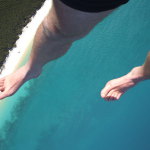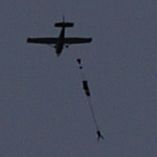Recommended Posts
Quote...and you couldn't inspect it for wear (a bug, but one which modern jumpers including me cheerfully accept from UPT these days)....
What's UPT got going now that you cannot inspect for wear?
I'm not arguing, I just want to know. Thanks.
QuoteNot just your normal pin check
Here's an extract from Capewell S.B
6. Apply a load of 15 lbs. (6.8kg) straight up and 90 degrees to the axis of the pin for a period of 3 seconds
and then release the load (Fig. 2). Inspect the pin for any deformation or bend. If the pin is straight,
continue with step 7 below. If the pin is not straight, as visible without magnification, remove the
pin/ripcord from service immediately.
7. Mark the inspected side of the pin with the felt marker to avoid repeatedly testing the same side of the
pin.
8. Rotate the pin one-quarter turn and test again as in step 6.
9. Repeat the procedure in step 6 until the pin has been tested in four positions and rotated one-quarter turn
in the same direction prior to each test.
The pin in question only reached a force of 8-10 lbs on the very first attempt. It literally surprised the shit out of me on how little force was required to snap the pin with little or no bending involved. Hence this thread, all i'm trying to do is let people know that there are still "brittle" pins out there that are outside the dates noted in Capewells' S.B.
Link to full Capewell S.B sorry couldn't attach file.
http://hq.apf.asn.au:85/images/e/e0/SBCW03-01.pdf
Mat
Not to add alarm to the situation, but pause for thought. Sandy (RI) and Fliteline both sourced thier ripcords from the same supplier. I'm not in the business any more, Action air in Davis CA handles all Reflex related business these days. Might be worth a look see to determine if it is a systemic problem or a "one off".
Mick.
erdnarob 1
The pin of the Skyhook is thicker, is not swaged and has more or less a square (with corners rounded up) cross section. A friend of mine who is a master rigger changed for than kind of pin despite he doesn't have a Skyhook.
Those round pins are used for seventy years and were designed first for metal cones on military rigs. My idea is that, it is maybe the time to change for something ticker like the skyhook type of pin since the tension on the reserve single closing loop now can reach 200 lbs +.





I had some discussion with Nancy at Jumpshack about the pins they produce in their metal shop. Properly hardened pins should be able to be bent like 90 degrees and straightened again without snapping like a piece of glass.
-Michael
Share this post
Link to post
Share on other sites